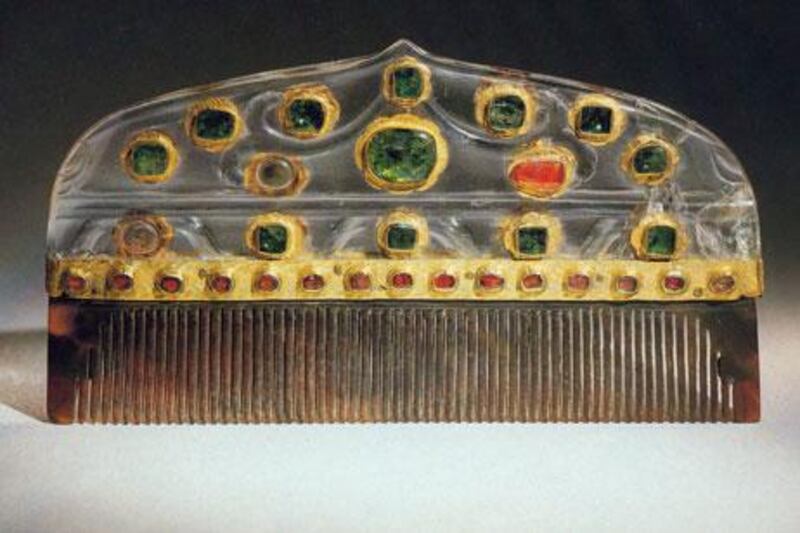In 1436, the Egyptian ambassadors to the Iranian court gave their hosts a special gift, special because no one had seen anything like it - a giraffe. An Iranian artist recorded the gift in ink, watercolour and gold.
In a group portrait that is also on view - Shah Jahan Receives the Persian Ambassador, Muhammad Ali Beg (1650) - the Mogul emperor who built the Taj Mahal is visited, not just by the Persian ambassador but by a retinue of gift-bearers and decorated horses.
Jewels, textiles, pages from the Quran, portraits of rulers and pictures of rare animals are among the 225 objects in Gifts of the Sultan: The Arts of Giving at the Islamic Courts. The show, now on at the Los Angeles County Museum of Art, is due to move to Doha's Mathaf: Arab Museum of Modern Art, next year from March 19 to June 2.
The objects are gifts made to, from and among Islamic countries. The pictures that are not gifts include depictions of gift-giving events, such as Shah Jahan's admitting the Persian ambassador to his court.
The most ambitious exhibition of Islamic art ever shown in Los Angeles was conceived and organised by the curator Linda Komaroff.
"What I found was that gift-giving at the Islamic courts was a frequent nexus of art and diplomacy, art and religion, and art and interpersonal relations," she says.
Komaroff defines gift-giving and the intentions behind it broadly. Gifts conveyed messages between countries, not simply in the objects themselves, but in their presentation. Gifts from the ruled signified respect for rulers. Some gifts were outright tribute, or taxes. Objects given at court forged personal bonds that greased the wheels of diplomacy. Rare, beautiful and historically significant objects were prized. So were objects of great expense, which were inventoried in writings about the objects.
"In the end, it is not necessarily the thought that counts, but the price tag," Komaroff notes candidly in the exhibition catalogue.
Conceived so broadly, the process of gift-giving was crucial to diplomacy, civic and religious philanthropy, and to the international exchange of art and wealth. Gifts, then and now, are rarely acts of pure generosity, says Komaroff, who notes that the exchanges of objects (and cash) reflect relations of power and obligation.
"There are ambassadors who made the mistake, or whose bosses made the mistake, of not bringing an important enough gift or of arriving empty-handed," she says. "They returned home empty-handed, or with the prospect of not having advanced diplomacy any further."
Surveying those relations from the 12th to the 19th century through a spectrum of styles and characters from Spain to China, the exhibition offers beauty to the connoisseur, but also speaks to students of diplomacy and manners.
Portraits of rulers, which were frequent gifts, could be expressions of authority, or efforts to cling to images of power that were more wish fulfilment than reality. One such ruler was Fath 'Ali Shah Qajar of Iran, who ruled from 1797 to 1834. Fath 'Ali Shah sent oil paintings of himself, dark-bearded and draped in jewels, to European powers, just as those powers were chipping away at his borders. If nothing else, the portraits documented the country's vast wealth that Fath 'Ali Shah was willing to spend on himself.
Re-gifting, a practice that many in the West now disparage, carried no such stigma. Many of those works are now in the world's major museums. Before getting there, objects travelled long distances, from one sovereign to another, and on to another, often crossing religious boundaries.
The images of Shah Jahan's court come from an illuminated manuscript that belongs to Queen Elizabeth II. The Padshahnama, an illustrated biography of the 30-year reign of Shah Jahan (1628-58), was presented to George III, who ruled from 1760 to 1820. The British governor-general of India had declined the gift, suggesting that it "might be acceptable to the King of Great Britain".
Another case in point is Rhinoceros, a print from 1515 by the German artist Albrecht Durer, which depicts an animal that Sultan Muzafar II, the sovereign of Gujarat, gave to Alfonso d'Albuquerque, the governor of Portuguese India. Durer, a prodigious draftsman, heard about the exotic beast and made a drawing based on what he'd been told about, but never saw. He then made a print in remarkable detail. The unfortunate animal was given to the king of Portugal, and then died in a shipwreck in 1515 while being transported as a gift to yet another owner, Pope Leo X.
Gifts of the Sultan shares a huge new building for temporary shows at the LA museum with a Tim Burton retrospective and a survey of the work of the abstract sculptor David Smith. After it closes in Los Angeles on September, the show travels to the Museum of Fine Arts, Houston (October 23 to January 15) before it is moved to Doha.
The exhibition begins with jewellery, which would have been most transportable and most valuable by weight. Some of the earliest works in the show are a pair of 11th-century gold bracelets decorated with repousse that came from Egypt or Syria. Gift-giving was a widespread practice under the Fatimid Dynasty, which ruled Egypt from 969 to 1171. From Ottoman Turkey, where gift-giving also flourished, a delicate rock crystal comb from the late 16th or 17th century is studded with emeralds.
Ottoman holdings play a special role in Gifts of the Sultan. Since Istanbul was never conquered or looted under the Ottomans, Topkapi Palace became a repository for centuries of gifts, such as a dark green kaftan from 16th-century Iran embroidered with silver thread. Topkapi, with its holdings intact, suggests what royal collections might have looked like in cities where they were dispersed in war or revolution.
Another section of the exhibition is devoted to pious gifts, those made to religious shrines. The objects share an inspiration, a hadith (a record of the words and deeds of the Prophet Mohammed) that reads: "He who believes in recompense [from God] is generous with gifts." The inscription is found on an elegant earthenware 10th-century bowl from eastern Iran, produced during the Samanid dynasty.
From north-western Iran, also on view, is the extraordinary Ardabil carpet, which was created in 1539-40 by the Persian master Maqsud Kashani as part of a matching pair for the shrine of the Sufi Sheik Safi Al-Din. One of the two Ardabil carpets ended up in the Victoria and Albert Museum in London. The carpet on view was sold by the London dealer Joseph Duveen to the oilman Jean Paul Getty, who gave it as a gift to the museum in 1953, a year before Getty decided to establish his own museum in Los Angeles.
The exhibit's Ardabil carpet, borders of which were removed to restore its twin in London, is rarely on view. If the exhibition has a centrepiece, this profusion of floral patterns is it.
Originally, the grand gesture of Gifts of the Sultan was to be sections of a red and yellow Imperial tent that the Ottoman court used during military campaigns. Sultan Selim III presented the sumptuous enclosure to Catherine the Great of Russia after the signing of the treaty ending the second Russo-Turkish War (1787-92).
Yet a dispute involving a Russian loan to another US institution last summer halted all art loans from Russia to the US, which meant that the tent and 37 other objects promised to the exhibition never left Russia. According to Komaroff, however, the Russian museums will loan those works to Doha. Diplomacy, as the exhibition suggests, is always a work in progress.





